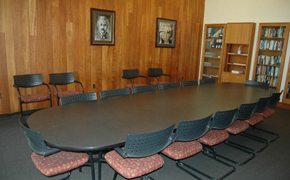This Course at MIT pages are part of the OCW Educator initiative, which seeks to enhance the value of OCW for educators.
Course Overview
This page focuses on the course 21L.705 Major Authors: Old English and "Beowulf" as it was taught by associate professor Arthur Bahr in Spring 2014.
Traditionally, this is a two semester sequence with the first semester covering Old English and the second semester focusing on reading Beowulf. This course, however, compressed Old English vocabulary and grammar into the first six weeks, followed by reading and literary critical conversations of several passages in Old English, riddles and Beowulf.
Course Outcomes
Course Goals for Students
Students should be able to read Old English. When faced with a sentence in Old English, students should be able to navigate it - identifying the verb, subject and cases.
Possibilities for Further Study/Careers
Because of interest from the students in this course, professor Bahr extended Old English and "Beowulf" into a more advanced course.
My goal for the course was for students to read Old English. I wanted them, if they were faced with a sentence in Old English, to be able to confidently navigate it.
—Arthur Bahr
In the following pages, professor Bahr describes various aspects of how he taught 21L.705 Major Authors: Old English and "Beowulf".
Curriculum Information
Prerequisites
Completion of 2 previous literature courses.
Requirements Satisfied
- CI-M

- HASS-H

Offered
21L.705 is a seminar course taught in the spring and fall semesters, though the instructor and focal topics vary. This was the first iteration of 21L.705 Major Authors: Old English and "Beowulf".
Assessment
The students' grades were based on the following activities:
 15% Daily vocab quizzes
15% Daily vocab quizzes 30% Exams 1 and 2 (15% each)
30% Exams 1 and 2 (15% each) 30% Final exam
30% Final exam 25% Participation
25% ParticipationStudent Information

Breakdown by Year
Students were predominantly juniors or seniors, with a few sophomores and graduate students.
Breakdown by Major
Students were mostly non-majors, with a small number of literature double majors.
Enrollment Cap
12 students
Ideal Class Size
10-12 students is the ideal size because each class session included translation activities completed by each student in succession.
During an average week, students were expected to spend 12 hours on the course, roughly divided as follows:
In Class
- Met 2 times per week for 1.5 hours per session; 25 sessions total; mandatory attendance
- Vocab quiz at the start of each class, followed by student questions
- Every session included translations by each student and class discussions
- Discussion of mock exams in 2 sessions
- 3 exams
Out of Class
- Completed readings
- Completed vocab and grammar activities from Baker
- Completed mock exams
Semester Breakdown
| WEEK | M | T | W | Th | F |
|---|---|---|---|---|---|
| 1 |  |  |  |  |  |
| 2 |  |  |  |  |  |
| 3 |  |  |  |  |  |
| 4 |  |  |  |  |  |
| 5 |  |  |  |  |  |
| 6 |  |  |  |  |  |
| 7 |  |  |  |  |  |
| 8 |  |  |  |  |  |
| 9 |  |  |  |  |  |
| 10 |  |  |  |  |  |
| 11 |  |  |  |  |  |
| 12 |  |  |  |  |  |
| 13 |  |  |  |  |  |
| 14 |  |  |  |  |  |
| 15 |  |  |  |  |  |
| 16 |  |  |  |  |  |
 No classes throughout MIT
No classes throughout MIT Class meeting
Class meeting Quiz
Quiz Mock exam due
Mock exam due No class session scheduled
No class session scheduled Mock exam discussion
Mock exam discussion Exam
Exam

 Room 1 of 1
Room 1 of 1 